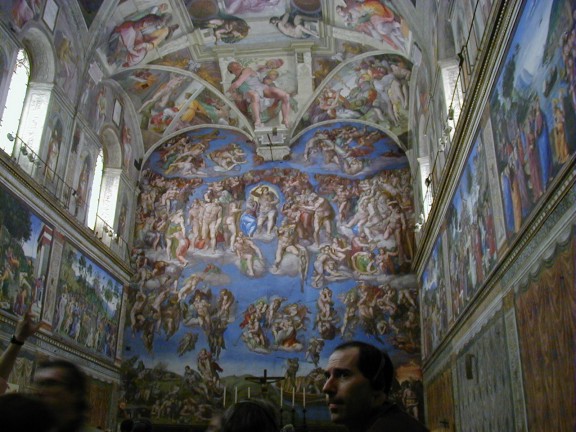| Sistine Chapel | ||
|
ROME SIGHTS
Colosseum Roman Forum Sistine Chapel Trevi Fountain St Peters Square Basilica Vatican Museums Pantheon Piazza Navona Spanish Steps
ODD ROME
VISIT THE WORLD FAMOUS...
EuroBlog!!!!! |
 Sistine Chapel
Distance from hotel: 3.5 miles (About 10 minutes)
THE HISTORY The Sistine Chapel is a religious chapel and one of the most famous artistic treasures of the Vatican, built between 1475 and 1483, in the time of Pope Sixtus IV della Rovere. The chapel is rectangular in shape and measures 40.93 meters long by 13.41 meters wide (the dimensions of the Temple of Solomon, as given in the Old Testament). It is 20.70 meters high and is roofed by a flattened barrel vault, with little side vaults over the 6 centered windows. The pavement (15th century) is in opus alexandrinum. A transenna in marble by Mino da Fiesole, Andrea Bregno and Giovanni Dalmata divides the chapel into two parts; the wider one, together with the altar, is reserved for proper religious ceremonies and other clergy uses, and the smaller one for the faithful. The passage (cancellata, gateway) was originally in gilt iron and more central; it was moved later toward the faithful area to grant a wider space for the pope. By the same artists is the Cantoria, the space for the chorus. During important ceremonies, side walls are covered with a series of tapestries (by Raphael) depicting events from the Gospels and the Acts of the Apostles. The architectural plans were made by Baccio Pontelli and the construction work was supervised by Giovannino de' Dolci between 1473 and 1784, at the orders of Sixtus IV. The first Mass in the Sistine Chapel was celebrated on August 9, 1483, as a ceremony by which it was consecrated and dedicated to the Assumption of the Virgin Mary. The wall paintings were executed by Pietro Perugino, Sandro Botticelli, Domenico Ghirlandaio, Cosimo Rosselli, Luca Signorelli and their respective workshops, which included Pinturicchio, Piero di Cosimo and Bartolomeo della Gatta. The subjects of the pictures were historical religious themes, selected and divided according to the medieval concept of the partition of the world history into three epochs: before the ten commandments were given to Moses, between Moses and Christ's birth, and the Christian era thereafter. They underline the continuity between the Old Covenant and the New Covenant, or the transition from the Mosaic law to the Christian religion. Michelangelo Buonarroti was commissioned by Pope Julius II della Rovere in 1508 to repaint the ceiling, originally representing golden stars on a blue sky; the work was completed between 1508 and November 1, 1512. He painted the Last Judgement over the altar, between 1535 and 1541, being commissioned by Pope Paul III Farnese. To be able to reach the ceiling, Michelangelo needed a support; the first idea was by Bramante, who wanted to build for him a special scaffold, suspended in the air with ropes. But Michelangelo suspected that this would have left holes in the ceiling once the work was ended, so he built a scaffold of his own, a flat wooden platform on brackets built out from holes in the wall, high up near the top of the windows. The first layer of plaster began to grow mould because it was too wet. Michelangelo had to remove it and start again, but he tried a new mixture, called intonaco, created by one of his assistants, Jacopo l'Indaco. This one not only resisted mould, but also entered the Italian building tradition (and is still now in use). Michelangelo was employed to paint only 12 figures, the Apostles, but when the work was finished there were more than 300. The sketches are a really precious and curious document. Michelangelo used male models, even for the females, because female models were more rare and costly than male ones. The Last Judgement was an object of a heavy dispute between Cardinal Carafa and Michelangelo: the artist was accused of immorality and intolerable obscenity, having depicted naked figures, with genitals in evidence, inside the most important church of Christianity, so a censorship campaign (known as the "Fig-Leaf Campaign") was organized by Carafa and Monsignor Sernini (Mantua's ambassador) to remove the frescoes. When the Pope's own Master of Ceremonies, Biagio da Cesena, similarly denounced the work by saying that the work was more suited to a bath-house than a chapel, Michelangelo worked his semblance into the scene as Minos, judge of the underworld. It is said that when da Cesena complained to the Pope, the pontiff responded that his jurisdiction did not extend to hell, so the portrait would have to remain. In coincidence with Michelangelo's death, a law was issued to cover genitals ("Pictura in Cappella Ap.ca coopriantur"). So Daniele da Volterra, an apprentice of Michelangelo that after this work was nicknamed "Braghettone" (literally: "large pants"), covered with sort of perizomas (briefs) the genitals, leaving unaltered the complex of bodies. When the work was restored in 1993, the restorers chose not to remove the perizomas of Daniele; however, a faithful, uncensored copy of the original, by Marcello Venusti, is now in Naples, at the Capodimonte Museum.
|